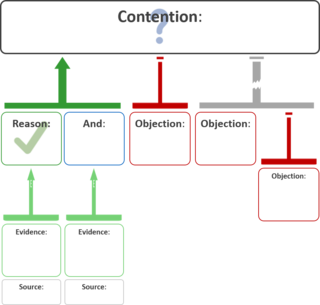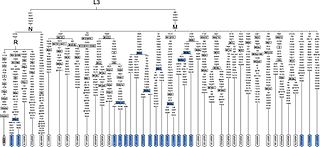
In psychology, decision-making is regarded as the cognitive process resulting in the selection of a belief or a course of action among several possible alternative options. It could be either rational or irrational. The decision-making process is a reasoning process based on assumptions of values, preferences and beliefs of the decision-maker. Every decision-making process produces a final choice, which may or may not prompt action.
Creative problem-solving (CPS) is the mental process of searching for an original and previously unknown solution to a problem. To qualify, the solution must be novel and reached independently. The creative problem-solving process was originally developed by Alex Osborn and Sid Parnes. Creative problem solving (CPS) is a way of using creativity to develop new ideas and solutions to problems. The process is based on separating divergent and convergent thinking styles, so that one can focus their mind on creating at the first stage, and then evaluating at the second stage.
Policy analysis or public policy analysis is a technique used in the public administration sub-field of political science to enable civil servants, nonprofit organizations, and others to examine and evaluate the available options to implement the goals of laws and elected officials. People who regularly use policy analysis skills and techniques on the job, particularly those who use it as a major part of their job duties are generally known by the title policy analyst. The process is also used in the administration of large organizations with complex policies. It has been defined as the process of "determining which of various policies will achieve a given set of goals in light of the relations between the policies and the goals."
Decision analysis (DA) is the discipline comprising the philosophy, methodology, and professional practice necessary to address important decisions in a formal manner. Decision analysis includes many procedures, methods, and tools for identifying, clearly representing, and formally assessing important aspects of a decision; for prescribing a recommended course of action by applying the maximum expected-utility axiom to a well-formed representation of the decision; and for translating the formal representation of a decision and its corresponding recommendation into insight for the decision maker, and other corporate and non-corporate stakeholders.
In planning and policy, a wicked problem is a problem that is difficult or impossible to solve because of incomplete, contradictory, and changing requirements that are often difficult to recognize. It refers to an idea or problem that cannot be fixed, where there is no single solution to the problem; and "wicked" denotes resistance to resolution, rather than evil. Another definition is "a problem whose social complexity means that it has no determinable stopping point". Moreover, because of complex interdependencies, the effort to solve one aspect of a wicked problem may reveal or create other problems. Due to their complexity, wicked problems are often characterized by organized irresponsibility.

Group concept mapping is a structured methodology for organizing the ideas of a group on any topic of interest and representing those ideas visually in a series of interrelated maps. It is a type of integrative mixed method, combining qualitative and quantitative approaches to data collection and analysis. Group concept mapping allows for a collaborative group process with groups of any size, including a broad and diverse array of participants. Since its development in the late 1980s by William M.K. Trochim at Cornell University, it has been applied to various fields and contexts, including community and public health, social work, health care, human services, and biomedical research and evaluation.
Futures techniques used in the multi-disciplinary field of futurology by futurists in Americas and Australasia, and futurology by futurologists in EU, include a diverse range of forecasting methods, including anticipatory thinking, backcasting, simulation, and visioning. Some of the anticipatory methods include, the delphi method, causal layered analysis, environmental scanning, morphological analysis, and scenario planning.

An argument map or argument diagram is a visual representation of the structure of an argument. An argument map typically includes all the key components of the argument, traditionally called the conclusion and the premises, also called contention and reasons. Argument maps can also show co-premises, objections, counterarguments, rebuttals, and lemmas. There are different styles of argument map but they are often functionally equivalent and represent an argument's individual claims and the relationships between them.
The engineering design process, also known as the engineering method, is a common series of steps that engineers use in creating functional products and processes. The process is highly iterative – parts of the process often need to be repeated many times before another can be entered – though the part(s) that get iterated and the number of such cycles in any given project may vary.

The following outline is provided as an overview of and topical guide to thought (thinking):
The rational planning model is a model of the planning process involving a number of rational actions or steps. Taylor (1998) outlines five steps, as follows:

Value-stream mapping, also known as material- and information-flow mapping, is a lean-management method for analyzing the current state and designing a future state for the series of events that take a product or service from the beginning of the specific process until it reaches the customer. A value stream map is a visual tool that displays all critical steps in a specific process and easily quantifies the time and volume taken at each stage. Value stream maps show the flow of both materials and information as they progress through the process.

A design rationale is an explicit documentation of the reasons behind decisions made when designing a system or artifact. As initially developed by W.R. Kunz and Horst Rittel, design rationale seeks to provide argumentation-based structure to the political, collaborative process of addressing wicked problems.

The issue-based information system (IBIS) is an argumentation-based approach to clarifying wicked problems—complex, ill-defined problems that involve multiple stakeholders. Diagrammatic visualization using IBIS notation is often called issue mapping.

Decision intelligence is an engineering discipline that augments data science with theory from social science, decision theory, and managerial science. Its application provides a framework for best practices in organizational decision-making and processes for applying computational technologies such as machine learning, natural language processing, reasoning, and semantics at scale. The basic idea is that decisions are based on our understanding of how actions lead to outcomes. Decision intelligence is a discipline for analyzing this chain of cause and effect, and decision modeling is a visual language for representing these chains.

Compendium is a computer program and social science tool that facilitates the mapping and management of ideas and arguments. The software provides a visual environment that allows people to structure and record collaboration as they discuss and work through wicked problems.
Robust decision-making (RDM) is an iterative decision analytics framework that aims to help identify potential robust strategies, characterize the vulnerabilities of such strategies, and evaluate the tradeoffs among them. RDM focuses on informing decisions under conditions of what is called "deep uncertainty", that is, conditions where the parties to a decision do not know or do not agree on the system models relating actions to consequences or the prior probability distributions for the key input parameters to those models.
Opportunity management (OM) has been defined as "a process to identify business and community development opportunities that could be implemented to sustain or improve the local economy".

Problem structuring methods (PSMs) are a group of techniques used to model or to map the nature or structure of a situation or state of affairs that some people want to change. PSMs are usually used by a group of people in collaboration to create a consensus about, or at least to facilitate negotiations about, what needs to change. Some widely adopted PSMs include

Value tree analysis is a multi-criteria decision-making (MCDM) implement by which the decision-making attributes for each choice to come out with a preference for the decision makes are weighted. Usually, choices' attribute-specific values are aggregated into a complete method. Decision analysts (DAs) distinguished two types of utility. The preferences of value are made among alternatives when there is no uncertainty. Risk preferences solves the attitude of DM to risk taking under uncertainty. This learning package focuses on deterministic choices, namely value theory, and in particular a decision analysis tool called a value tree.










